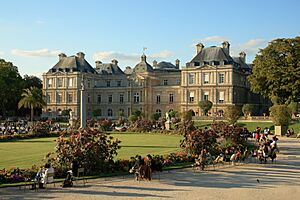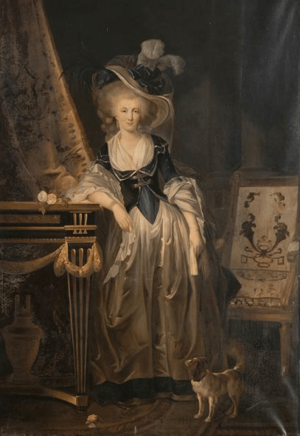Louise Marie Adélaïde de Bourbon, Duchess of Orléans facts for kids
Quick facts for kids Louise Marie Adélaïde de Bourbon |
|
|---|---|
| Duchess of Orléans | |

Portrait by Élisabeth-Louise Vigée-Le Brun
|
|
| Born | 13 March 1753 Hôtel de Toulouse, Paris, France |
| Died | 23 June 1821 (aged 68) Château d'Ivry-sur-Seine, France |
| Burial | Chapelle royale de Dreux |
| Spouse | |
| Issue Detail |
Louis Philippe I, King of the French Antoine Philippe, Duke of Montpensier Françoise d'Orléans Adélaïde d'Orléans Louis Charles, Count of Beaujolais |
| House | Bourbon |
| Father | Louis Jean Marie de Bourbon, Duke of Penthièvre |
| Mother | Princess Maria Teresa d'Este |
| Religion | Roman Catholic |
Louise Marie Adélaïde de Bourbon (born March 13, 1753 – died June 23, 1821) was a French princess. She was known as the Duchess of Orléans. Her father was Louis Jean Marie de Bourbon, Duke of Penthièvre, and her mother was Princess Maria Teresa d'Este.
When her brother, Louis Alexandre, Prince of Lamballe, passed away, Louise Marie Adélaïde became one of the richest heiresses in France. This was just before the French Revolution. She married Louis Philippe II, Duke of Orléans, who was also known as Philippe Égalité. She was the mother of Louis Philippe I, who became the last king of France. She was also the last member of the Bourbon-Penthièvre family.
Contents
Early Life and Family
Marie-Adélaïde was born on March 13, 1753. Her family lived in a grand house in Paris called the Hôtel de Toulouse. Her grandfather had bought this house many years before.
She was the youngest daughter of the Duke of Penthièvre and Princess Maria Teresa d'Este. Sadly, her mother died the year after she was born. When she was very young, she was called Mademoiselle d'Ivoy. Later, until she got married, she was known as Mademoiselle de Penthièvre. This title came from her father's duchy. Her older sister, Marie Louise, had also used this title but passed away when Marie-Adélaïde was just six months old.
Her Education
When Marie-Adélaïde was born, she was cared for by a woman named Madame de Sourcy. Like many noble girls of her time, she was later raised in a convent. This was the Abbaye de Montmartre, which overlooked the city of Paris. She lived there for twelve years.
As a child, she was taught to help with the many charities her father supported. He was known as the "Prince of the Poor" because he was so kind and generous. His good reputation helped protect him and his family during the difficult times of the French Revolution.
Her Marriage
On May 8, 1768, Marie-Adélaïde's only brother, the Prince de Lamballe, died. This made her the sole heir to a huge family fortune. It was set to become the largest fortune in France.
Before this, there had been talks about her marrying Louis Philippe Joseph d'Orléans. He was the Duke of Chartres and a cousin. Her father, the Duke of Penthièvre, thought this would be a great marriage for his daughter. It would connect her to a very important royal family branch. At first, the Orléans family was not keen on marrying someone from an "illegitimate" branch of the royal family. But once Marie-Adélaïde became so wealthy, they changed their minds.
King Louis XV warned her father about the marriage. He knew the young Duke of Chartres had a reputation for not being very responsible. The King was also worried about how powerful the Orléans family would become with such a large fortune.
On December 7, 1768, Marie-Adélaïde was formally presented to the King. This was a special ceremony for young noblewomen before marriage. She was greeted by King Louis XV, the Dauphin (the future King Louis XVI), and other members of the royal family. On this day, she was also officially baptized and given the names Louise Marie Adélaïde.
Her wedding to the Duke of Chartres happened at the Palace of Versailles on April 5, 1769. All the important royal princes attended the ceremony. The marriage contract was signed by everyone in the royal family. After the wedding, King Louis XV hosted a special dinner for the entire royal family. Marie-Adélaïde brought a dowry of six million livres (a type of money). She also had an annual income of 240,000 livres, which later increased. She was also expected to inherit much more when her father passed away.
The French Revolution
On April 5, 1791, Marie-Adélaïde left her husband. She went to live with her father at his castle, the château de Bizy, in Normandy.
In September 1792, her husband, the Duke of Orléans, supported the French Revolution. He was chosen to be part of the National Convention, a new government body. He took the name Philippe Égalité. However, he was soon viewed with suspicion by some groups.
The future of the Orléans family became uncertain when Marie-Adélaïde's oldest son, the Duke of Chartres, left France in March 1793. He was a general in the army and sought safety with the Austrians. On April 6, all members of the Orléans family still in France were arrested. Philippe Égalité and his son, the Count of Beaujolais, were put in prison in Paris. Later, they were moved to a prison in Marseille. They were soon joined by another son, the Duke of Montpensier.
Before his father and brothers were arrested, the Duke of Chartres helped his sister Adélaïde and her governess escape to Switzerland. Because Marie-Adélaïde was in poor health, she was allowed to stay at the château de Bizy, but she was guarded. Her father had passed away there a month earlier. The new revolutionary government took away her inheritance. Even though her husband had voted for the death of his cousin, Louis XVI of France, and had spoken against his own son's actions, Philippe Égalité was executed on November 6, 1793.
Widow Égalité

After her husband was executed, Marie-Adélaïde became known as the "Veuve Égalité" (the "Widow Égalité"). She was imprisoned at the Luxembourg Palace, which had become a prison during the Revolution. There, she met Jacques-Marie Rouzet, a former politician who was also imprisoned.
She was almost executed herself, but she was saved when the Reign of Terror ended in July 1794. She was then moved to another place called "Pension Belhomme." This used to be a mental hospital but became a "prison for the rich" during the Revolution.
Rouzet was freed and later helped secure Marie-Adélaïde's release in 1796. He also helped free her two sons who were still in prison in Marseille. Marie-Adélaïde and Rouzet lived together in Paris until 1797. At that time, a new law forced all remaining members of the House of Bourbon to leave France. Marie-Adélaïde was sent to Spain, along with her sister-in-law. Rouzet went with them to the Spanish border and secretly joined them in Barcelona. He became her assistant, and she helped him get the title of comte de Folmont.
Marie-Adélaïde never saw her two younger sons, Montpensier and Beaujolais, again. They both died while in exile before the Bourbon monarchy was restored in 1814. She, Rouzet, and the Orléans family who were exiled in Spain returned to France in 1814. After many legal battles, she eventually got most of her inheritance back.
She passed away at her castle in Ivry-sur-Seine on June 23, 1821, after battling an illness. Rouzet had died nine months before her. She had him buried in a new family chapel she built in Dreux in 1816. This chapel was meant to be the final resting place for both the Bourbon-Penthièvre and Orléans families.
The original family burial place had been disturbed during the Revolution. Marie-Adélaïde was buried in the new chapel. Later, when her son Louis Philippe became King of the French, the chapel was made larger and more beautiful. It was renamed the Chapelle royale de Dreux and became the burial place for the royal Orléans family. Marie-Adélaïde did not live to see her son become king in 1830.
Her Children
Louise Marie Adélaïde and her husband had six children:
- A daughter (born and died on October 10, 1771)
- Louis Philippe d'Orléans (born 1773 – died 1850). He became Louis Philippe I, King of the French. He married Maria Amalia of Naples and had children.
- Louis Antoine Philippe d'Orléans, Duke of Montpensier (born 1775 – died 1807).
- Françoise d'Orléans, Mademoiselle d'Orléans (born 1777 – died 1782). She was a twin.
- Louise Marie Adélaïde Eugénie d'Orléans (born 1777 – died 1847). She never married.
- Louis Charles Alphonse Léodgard d'Orléans, Count of Beaujolais (born 1779 – died 1808). He never married.
Her Famous Painting
Just before the French Revolution began in 1789, Marie-Adélaïde was painted by Élisabeth-Louise Vigée-Le Brun. This artist was a favorite portrait painter of Queen Marie Antoinette. The painting was called Madame la Duchesse d'Orléans.
In the painting, Vigée-Le Brun showed the duchess looking a bit sad. She is dressed in white, which can represent purity. Her head is resting on her arm, giving her a thoughtful expression. The painting is now displayed at the Palace of Versailles. There is another copy in a museum in Marseille.
Images for kids
See also
 In Spanish: Luisa María Adelaida de Borbón para niños
In Spanish: Luisa María Adelaida de Borbón para niños




